Asian shore crab
Asian shore crab (Hemigrapsus sanguineus, also known as Pacific crab or Japanese shore crab) can be distinguished by the spots on its claws and 3 spines either side of the eyes. It is only a small species of crab, approximately 4cm shell width. It can be found in estuarine and marine habitats.
The Asian shore crab is currently not recorded in Australia, but if introduced, has the potential to compete with and prey upon native fish, crab and shellfish species. It is listed as prohibited matter under the NSW Biosecurity Act 2015 may not be brought into NSW or released or allowed to escape into any waters in NSW. Recent detection of this species in Port Phillip Bay, Victoria makes this species one of particular concern for translocation into NSW.
Reporting
If you think you have seen an Asian shore crab in NSW, please take several clear, high resolution photos of the crab. For identification, we need to see the:
- top of the crab’s shell (carapace)
- spines either side of the eyes
- top of the crab’s claw
- pattern on crab’s legs
Including something for size reference, like a coin or note, is useful in determining the size of the crab from photos.
Please send the photos to Aquatic.Biosecurity@dpi.nsw.gov.au, along with details of when and where the crab was seen.
Identification
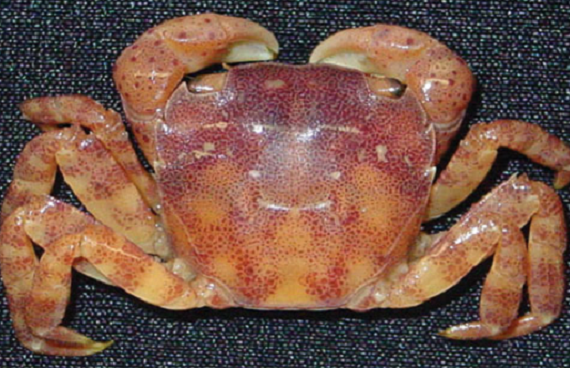 Key features:
Key features:
- Spots on claws
- 3 spines either side of the eyes
- Shell square up to 4cm wide
- Shell varied colour green/purple to orange/brown
- Banded pattern on legs
- No indentation between the eyes
- No hairs on legs
Known locations:
- Detected in Port Phillip Bay, Victoria in January 2021
- Not recorded elsewhere in Australia
Habitat:
- Estuarine and marine habitats
- Intertidal shallow hard-bottom areas including under rocks, shells, debris and artificial structures
Vectors:
- Vessels
Impacts:
- Broad diet, competes with and preys upon native species such as crabs and shellfish.
- Potential impact on aquaculture production due to predation on commercially important scallops, mussels and oysters.
- May also carry disease that could affect prawns, other crabs and lobsters.
Similar native species
These native species may be confused with this marine pest and do not need to be reported. But if unsure, take a photo and let us know.
Swift-footed crab (Leptograpsus variegatus)
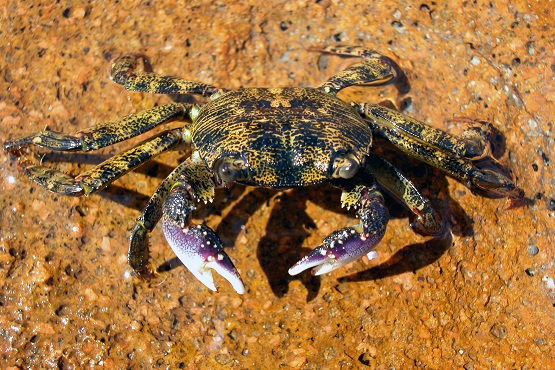
- Dark-olive green to dark purple
- Shell up to 8cm wide
- Large front claws are purple with white tips
- Three spines on either side of eyes
Known locations:
- QLD, NSW, VIC, Tasmania
- Is the most active and prominent crab on Sydney’s rocky coast.
Habitat:
- Exposed intertidal rocky shores
- No spines around the edges of the shell
- Smooth rounded shell up to 4cm wide
- Varied colours from red brown/purple and yellow to purple, dark grey or brownish grey
- From Hervey Bay QLD south through NSW, VIC, SA to Bunbury WA.
- Under rocks on sheltered and moderately exposed shores
- Smooth shell green-brown colour
- 4 distinct spines on either side of eyes
- Walking legs have sharp spines on the ends for grasping rock.
- From south-east QLD through NSW to the Victorian border
- Low level rocks shores, preferring to sit at the bottom of rock pools or in cracks and crevices.
- Shell width up to 4cm
- 2 spines either side of eyes
- Body yellow-brown with darker red patches
- First set of legs felted with hairs
- Gregarious species, often found in groups
- South-eastern QLD down through NSW and VIC; also found in TAS.
- Intertidal, sheltered coastal bays and estuaries
- Rarely found in the open, prefers hiding under rocks, debris, in mangroves and in burrows on mudflats.
Smooth shore crab (Cyclograpsus audouinii)
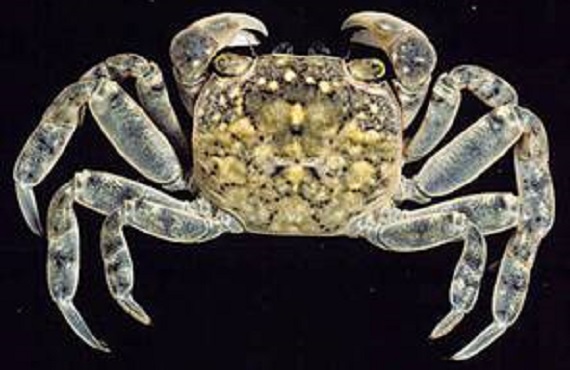
Key features:
Known locations:
Sowrie (Plagusia glabra)
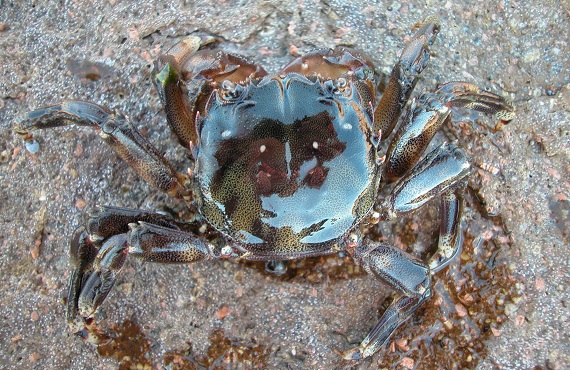
Key features:
Known locations:
Habitat:
Spotted smooth shore crab or Mottled shore crab (Paragrapsus laevis)
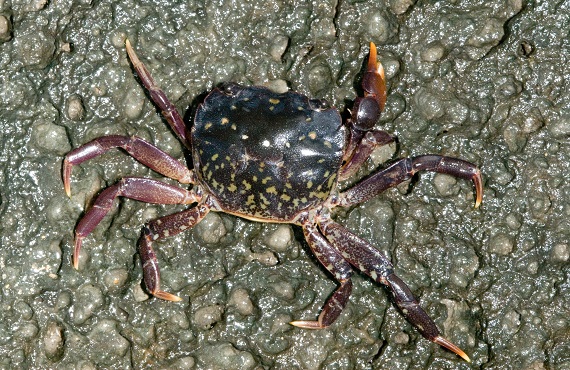
Key features:
Known locations:
Habitat: